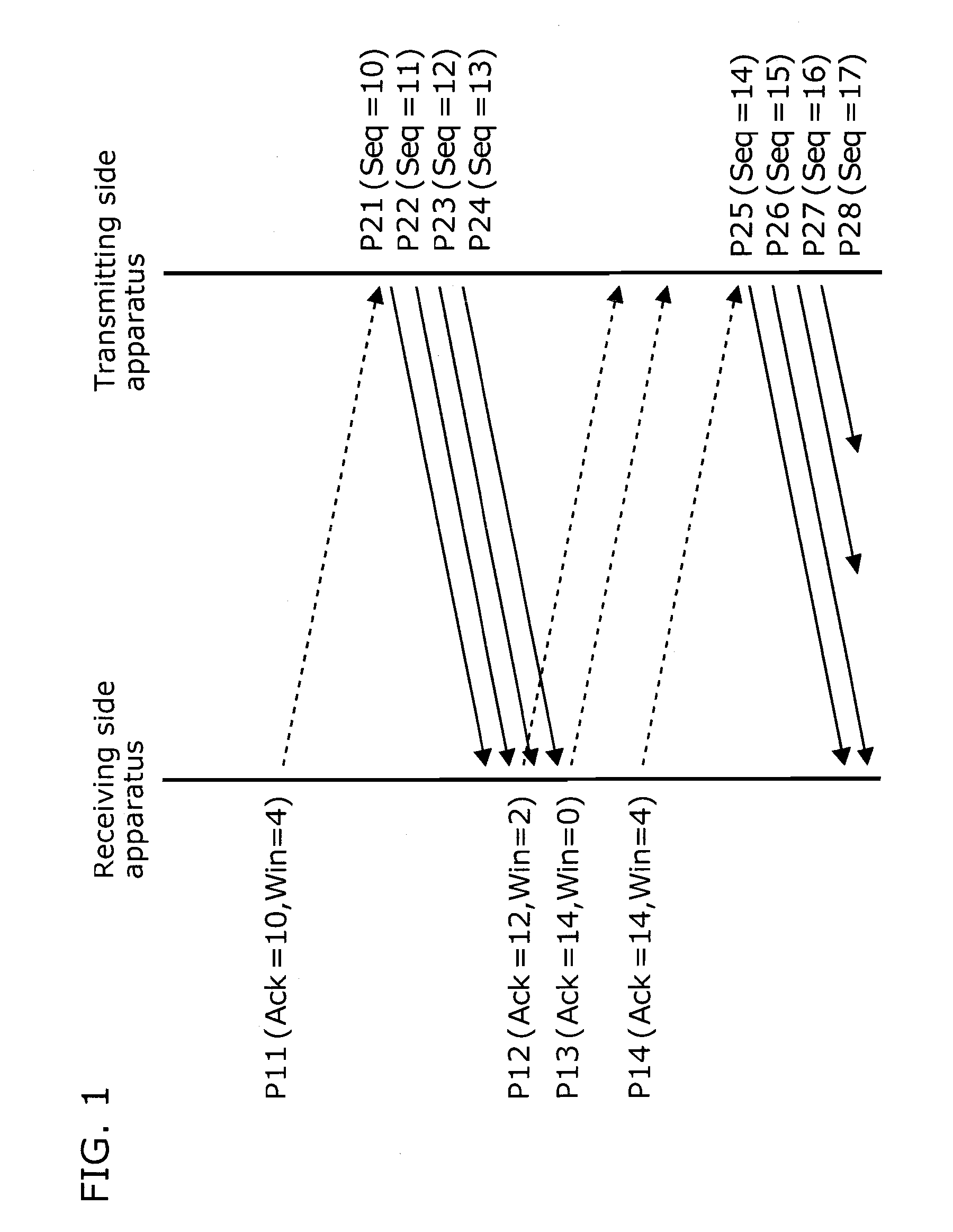Communication apparatus
a technology of communication apparatus and communication device, which is applied in the field of communication apparatus, can solve the problems of affecting the efficiency of data transfer, and the inability to store the data corresponding to the rwin_max (32 kb), so as to prevent throughput deterioration, reduce packet loss, and reduce the effect of data loss
- Summary
- Abstract
- Description
- Claims
- Application Information
AI Technical Summary
Benefits of technology
Problems solved by technology
Method used
Image
Examples
first embodiment
[0251]FIG. 8 is a diagram illustrating an example of a structure of a communication apparatus (receiving side apparatus) according to the present embodiment. A receiving side apparatus 31 is an apparatus connected to a network 37 via a wired or wireless connection, and has a communication function. It has an Ethernet(®) interface, for example. The network 37 is a network including a wired or wireless connection, an example of which includes a public network such as the Internet.
[0252]The receiving side apparatus 31 includes a system bus 32, a processing unit 33, a storing unit 34, and a communication unit 35.
[0253]The communication unit 35 is hardware connected to the system bus 32. The communication unit 35 has a function of transmitting a packet stored in the storing unit 34 to the network 37 and a function of receiving a packet from the network 37. In addition, the communication unit 35 has a storage region (hereinafter referred to as FIFO) 36 for temporarily holding the packet r...
example 1
[0268]An updating amount and a predetermined interval can be computed based on the capacity of the FIFO 36 and the transfer capability of the system bus 32, using the following expressions.
Updating amount=Capacity of the FIFO 36 (Expression 3)
Predetermined interval=Capacity of the FIFO 36 / Transfer capability of the system bus 32 (Expression 4)
[0269]To be more specific, in the case where the capacity of the FIFO 36 of the receiving side apparatus 31 is 4 KB and the transfer capability of the system bus 32 is 40 Mbps, the updating amount is 4 KB in conformance with the capacity of the FIFO 36, and the predetermined interval is 0.8 millisecond which is time that the system bus 32 requires for transferring 4 KB. It should be noted that the data transferring amount can be suppressed at or below the transfer capability of the system bus 32 by making the predetermined interval equal to or greater than 0.8 millisecond, and thus, the predetermined interval may be 1 millisecond. Furthermore...
example 2
[0270]An updating amount and a predetermined interval can be computed based on the capacity of the FIFO 36 and a bit rate required by an application, using the following expressions.
Updating amount=Capacity of the FIFO 36 (Expression 5)
Predetermined intervals=RTT / CEILING(((Bit rate required by application×RTT) / 8) / Updating amount, 1) (Expression 6)
It is assumed that CEILING (A, B) are the result of rounding up A to the unit of B.
[0271]To be more specific, in the case where: the size of the FIFO 36 of the receiving side apparatus 31 is 4 KB; the bit rate required by an application is 10 Mbps; and the RTT is 10 milliseconds, the updating amount is 4 KB in conformance with the size of the FIFO 36. Further, in this case, since the bit rate required by the application is 10 Mbps, it is necessary that the application receives data of 12.5 KB during one RTT (10 milliseconds). Accordingly, taking into account an increase of 4 KB at a time as the updating amount, 3.125 times of update, that...
PUM
 Login to View More
Login to View More Abstract
Description
Claims
Application Information
 Login to View More
Login to View More - R&D
- Intellectual Property
- Life Sciences
- Materials
- Tech Scout
- Unparalleled Data Quality
- Higher Quality Content
- 60% Fewer Hallucinations
Browse by: Latest US Patents, China's latest patents, Technical Efficacy Thesaurus, Application Domain, Technology Topic, Popular Technical Reports.
© 2025 PatSnap. All rights reserved.Legal|Privacy policy|Modern Slavery Act Transparency Statement|Sitemap|About US| Contact US: help@patsnap.com



